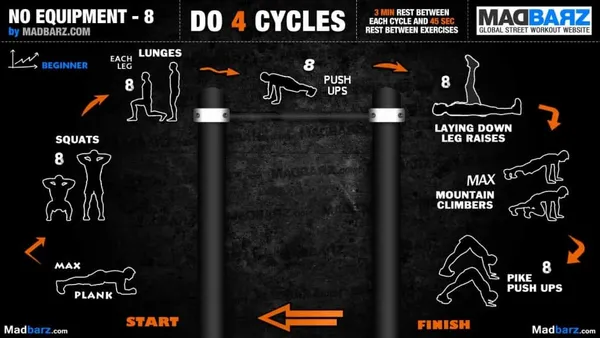Table of Contents
Calisthenics is a fantastic way to get in shape without any equipment. It's a great way to build strength, flexibility, and endurance, and it can be done anywhere. If you're looking for a challenging and effective workout, a calisthenics routine is a great option. At Kizworld, we offer a variety of calisthenics programs that can help you achieve your fitness goals.
The Ultimate Calisthenics Routine: Transform Your Body with Bodyweight Exercises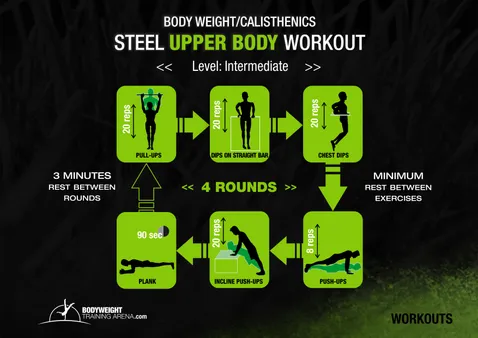
Calisthenics Routine | Benefits | Exercises | Tips |
|---|---|---|---|
Beginner | Improved strength, flexibility, and endurance | Push-ups, squats, lunges, planks | Start gradually, focus on form, and listen to your body |
Intermediate | Increased muscle mass, power, and coordination | Pull-ups, dips, handstands, muscle-ups | Challenge yourself with progressions, maintain good form, and recover adequately |
Advanced | Exceptional strength, agility, and body control | Weighted calisthenics, plyometrics, advanced progressions | Master the basics, train consistently, and push your limits safely |
I. Different Calisthenics Exercises
Bodyweight Exercises
Calisthenics exercises use your own body weight as resistance, making them accessible and effective for all fitness levels. Some popular bodyweight exercises include:
- Push-ups
- Squats
- Lunges
- Planks
- Pull-ups
- Dips
- Handstands
- Muscle-ups
These exercises target various muscle groups and can help you improve strength, flexibility, and endurance.
Weighted Calisthenics
As you progress in your calisthenics journey, you may want to add weight to your exercises to increase the challenge. Weighted calisthenics exercises can help you build muscle mass, power, and coordination. Some examples of weighted calisthenics exercises include:
- Weighted push-ups
- Weighted squats
- Weighted lunges
- Weighted pull-ups
- Weighted dips
When performing weighted calisthenics exercises, it's important to start gradually and use proper form to avoid injury.
Plyometrics
Plyometrics are explosive exercises that combine strength and speed. They can help you improve power, agility, and coordination. Some examples of plyometric exercises include:
- Box jumps
- Depth jumps
- Clapping push-ups
- Tuck jumps
- Burpees
Plyometrics can be challenging, so it's important to start gradually and listen to your body.
Advanced Calisthenics
Once you have mastered the basics of calisthenics, you can start to explore more advanced exercises. These exercises require a high level of strength, agility, and body control. Some examples of advanced calisthenics exercises include:
- Planche
- Front lever
- Back lever
- Human flag
- One-arm pull-up
Advanced calisthenics exercises can be very challenging, so it's important to train consistently and safely.No matter your fitness level, there is a calisthenics exercise that is right for you. With regular practice, you can improve your strength, flexibility, endurance, and overall fitness.
Exercise | Benefits | Difficulty |
|---|---|---|
Push-ups | Strengthens chest, shoulders, and triceps | Beginner |
Squats | Strengthens legs, glutes, and core | Beginner |
Lunges | Strengthens legs, glutes, and core | Beginner |
Planks | Strengthens core, back, and shoulders | Beginner |
Pull-ups | Strengthens back, biceps, and forearms | Intermediate |
Dips | Strengthens chest, triceps, and shoulders | Intermediate |
Handstands | Strengthens shoulders, core, and wrists | Advanced |
Muscle-ups | Strengthens back, biceps, and forearms | Advanced |
Check out our related posts on how to do a muscle-up, the best calisthenics gifts and accessories, and the best calisthenics quotes and motivation to learn more about this amazing fitness discipline.
Different Calisthenics Exercises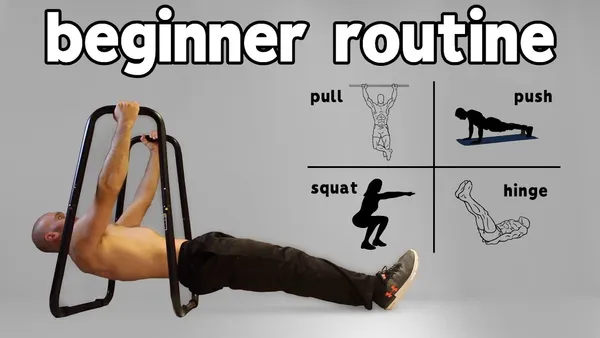
II. Calisthenics Training Schedule
Beginner Calisthenics Schedule
For beginners, it is important to start slowly and gradually increase the intensity and duration of your workouts over time. A good beginner calisthenics schedule might look something like this:
- Monday: Full-body workout (push-ups, squats, lunges, planks)
- Tuesday: Rest
- Wednesday: Upper-body workout (pull-ups, dips, rows)
- Thursday: Rest
- Friday: Lower-body workout (squats, lunges, calf raises)
- Saturday: Rest
- Sunday: Active recovery (yoga, walking, swimming)
As you progress, you can increase the frequency and intensity of your workouts. You can also add more exercises to your routine, such as muscle-ups, handstands, and plyometrics.
Intermediate Calisthenics Schedule
Once you have a solid foundation in calisthenics, you can move on to an intermediate training schedule. This type of schedule will help you to build more muscle, strength, and power.
A good intermediate calisthenics schedule might look something like this:
- Monday: Upper-body workout (pull-ups, dips, rows, muscle-ups)
- Tuesday: Lower-body workout (squats, lunges, calf raises, plyometrics)
- Wednesday: Rest
- Thursday: Full-body workout (push-ups, squats, lunges, planks, handstands)
- Friday: Rest
- Saturday: Active recovery (yoga, walking, swimming)
- Sunday: Rest
As you progress, you can continue to increase the frequency and intensity of your workouts. You can also add more exercises to your routine, such as weighted calisthenics and advanced progressions.
Advanced Calisthenics Schedule
If you are an experienced calisthenics athlete, you may want to follow an advanced training schedule. This type of schedule will help you to reach your full potential in terms of strength, power, and body control.
A good advanced calisthenics schedule might look something like this:
- Monday: Upper-body workout (weighted pull-ups, dips, rows, muscle-ups)
- Tuesday: Lower-body workout (weighted squats, lunges, calf raises, plyometrics)
- Wednesday: Rest
- Thursday: Full-body workout (push-ups, squats, lunges, planks, handstands, advanced progressions)
- Friday: Rest
- Saturday: Active recovery (yoga, walking, swimming)
- Sunday: Rest
As you progress, you can continue to increase the frequency and intensity of your workouts. You can also add more exercises to your routine, such as complex movements and dynamic exercises.
Calisthenics Exercise | Benefits |
|---|---|
Push-ups | Builds upper-body strength, especially in the chest, shoulders, and triceps |
Squats | Builds lower-body strength, especially in the quads, hamstrings, and glutes |
Lunges | Builds lower-body strength and stability, especially in the quads, hamstrings, and glutes |
Planks | Builds core strength and stability |
Pull-ups | Builds upper-body strength, especially in the back, biceps, and forearms |
Dips | Builds upper-body strength, especially in the chest, shoulders, and triceps |
Rows | Builds upper-body strength, especially in the back and biceps |
Muscle-ups | Builds upper-body strength and power, especially in the back, biceps, and forearms |
Handstands | Builds upper-body strength and stability, especially in the shoulders, wrists, and forearms |
Plyometrics | Builds lower-body power and explosiveness, especially in the quads, hamstrings, and glutes |
Calisthenics Training Schedule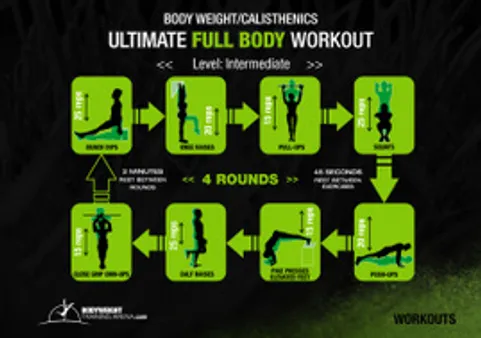
III. Beginner Calisthenics Routine
Getting Started with Calisthenics
Calisthenics is a great way to get in shape without any equipment. It's a bodyweight training method that uses exercises like push-ups, squats, lunges, and planks to build strength, flexibility, and endurance. Calisthenics is a great option for beginners because it's easy to learn and can be done anywhere.How to Get Started with Calisthenics as a Beginner
Beginner Calisthenics Exercises
There are many different calisthenics exercises that you can do, but some of the most basic and effective exercises for beginners include:
- Push-ups
- Squats
- Lunges
- Planks
- Pull-ups
Exercise | Benefits | How to Do It |
|---|---|---|
Push-ups | Strengthens chest, shoulders, and triceps | Start in a plank position with your hands shoulder-width apart. Lower your chest towards the ground by bending your elbows. Push back up to the starting position. |
Squats | Strengthens legs, glutes, and core | Stand with your feet shoulder-width apart. Lower your body by bending your knees and hips. Keep your chest up and your knees behind your toes. Push back up to the starting position. |
Lunges | Strengthens legs, glutes, and core | Step forward with one leg and bend your knee so that your thigh is parallel to the ground. Keep your other leg straight. Push back up to the starting position and repeat with the other leg. |
Planks | Strengthens core, back, and shoulders | Start in a push-up position with your forearms on the ground. Hold your body in a straight line from your head to your heels. |
Pull-ups | Strengthens back, arms, and shoulders | Hang from a pull-up bar with your hands shoulder-width apart. Pull yourself up until your chin is above the bar. Lower yourself back down to the starting position. |
Tips for Beginners
If you're new to calisthenics, here are a few tips to help you get started:
- Start slowly and gradually increase the difficulty of your workouts.
- Focus on proper form to avoid injury.
- Listen to your body and rest when you need to.
- Be patient and consistent with your workouts.
- Have fun!
The Best Calisthenics Exercises and Variations
Beginner Calisthenics Routine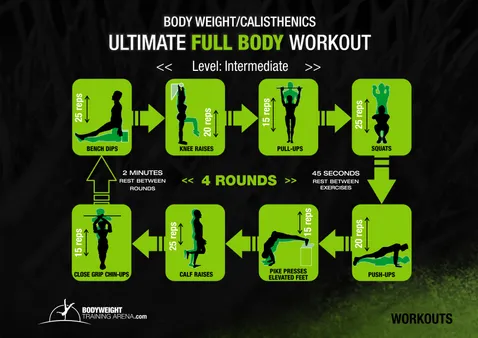
IV. Benefits Of Calisthenics
Calisthenics is a form of exercise that uses bodyweight as resistance. It is a great way to build strength, flexibility, and endurance, and it can be done anywhere, anytime.
There are many different calisthenics exercises, but some of the most popular include push-ups, pull-ups, squats, and lunges.
Calisthenics Exercise | Benefits |
|---|---|
Push-ups | Strengthen the chest, shoulders, and triceps |
Pull-ups | Strengthen the back, biceps, and forearms |
Squats | Strengthen the legs and glutes |
Lunges | Strengthen the legs and improve balance |
Calisthenics exercises can be modified to make them easier or more difficult, so they are suitable for people of all fitness levels.
Calisthenics is a great way to improve your overall fitness, and it is also a lot of fun.
- The related post The benefits of calisthenics for bodyweight training provides more information about the benefits of calisthenics.
- The related post The best calisthenics exercises and variations provides more information about the different calisthenics exercises.
- The related post How to design your own calisthenics routine and program provides more information about how to develop a calisthenics routine.
Benefits Of Calisthenics